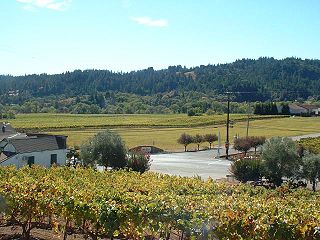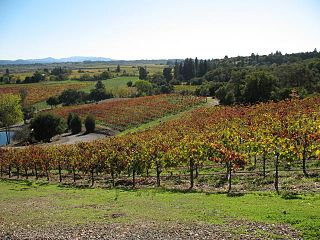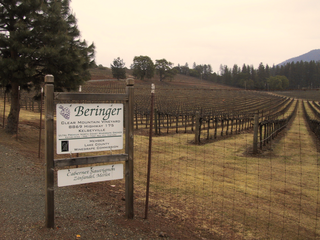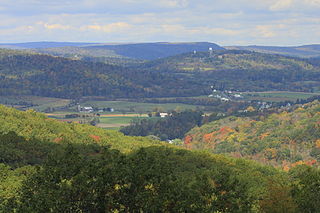Related Research Articles
Guenoc Valley is an American Viticultural Area in Lake County, California, United States, about 15 mi (24 km) north of the town of Calistoga. Guenoc Valley AVA was the first American Viticultural Area designation granted to an area with just a single winery.

The Dry Creek Valley AVA is an American Viticultural Area in Sonoma County, California, located northwest of the town of Healdsburg. The valley is formed by Dry Creek, a tributary of the Russian River, and is approximately 16 miles (25.7 km) long and 2 miles (3.2 km) wide. The appellation benefits from the proximity of the Lake Sonoma reservoir for irrigation in this relatively dry area.

The North Coast AVA is an American Viticultural Area in the state of California that encompasses grape-growing regions in six counties located north of San Francisco: Lake, Marin, Mendocino, Napa, Sonoma, and Solano. This large appellation covers over 3,000,000 acres (5,000 sq mi) and includes a number of smaller sub-appellations that all share the common ecology trait of weather affected by the fog and breezes off the Pacific Ocean.
The Northern Sonoma AVA is an American Viticultural Area in Sonoma County, California, United States. The appellation covers most of the county with the notable exceptions of the Los Carneros AVA and Sonoma Valley AVA wine regions, which are located in the southern portion of the county. The creation of this AVA was largely based on the petitioning of the E & J Gallo Winery as part of their expansion of their Gallo of Sonoma brand. The viticultural area incorporates the Alexander Valley AVA, Chalk Hill AVA, Dry Creek Valley AVA, Knights Valley AVA, Russian River Valley AVA, Sonoma Coast AVA, and parts of the Green Valley of Russian River Valley AVA and Rockpile AVA valleys.

St. Helena is an American Viticultural Area (AVA) located within Napa Valley, centered in and around the town of St. Helena, California. It was established by the Bureau of Alcohol, Tobacco and Firearms (ATF) on October 11, 1995, after the ATF received a petition from Mr. Charles A. Carpy, Chairman of the St. Helena Appellation Committee, proposing to establish a new viticultural area in Napa County to be known as "St. Helena."

Clear Lake is an American Viticultural Area (AVA) located in Lake County, California. It was established on June 7, 1984 by Bureau of Alcohol, Tobacco and Firearms (ATF), Treasury after reviewing the petition submitted by three of the grape-growers and winery owners located in an area surrounding the watershed of Clear Lake in southwestern Lake County. The petition requested the viticultural area to be named "Clear Lake."

Red Hills Lake County is an American Viticultural Area (AVA) located in Lake County, California and was established by Alcohol and Tobacco Tax and Trade Bureau (TTB), Treasury on September 10, 2004. The wine region lies along the southwestern shores of Clear Lake, separating Excelsior Valley to the east from Big Valley to the west. The hills lie at the foot of Mount Konocti, a volcano which last erupted 11,000 years ago, but which is still regarded as active. The terrain is rolling hills with elevations between 1,400 feet (430 m) and 3,000 feet (910 m) above sea level. Red Hills receives an average of 25 to 40 inches (635–1,016 mm) of rainfall annually.
The Willow Creek AVA is an American Viticultural Area located in the Humboldt and Trinity counties of northern California, near the town of Willow Creek. Surrounded by the Klamath Mountains, the AVA includes 6,000 acres (2,428 ha) in the center of the Six Rivers National Forest, and has had as many as five wineries and 30 acres (12 ha) in wine grape production. There are currently no commercially bonded wineries in the region, and only 10 acres (4 ha) in vineyards.
The Malibu-Newton Canyon Valley AVA is an American Viticultural Area in Los Angeles County, California. The boundaries of the AVA include Newton Canyon, located about 4 miles (6 km) from the Pacific Ocean within the city limits of Malibu. George Rosenthal planted the first vineyards planted in the area since Prohibition in 1987, and was successful in his petition for the creation of the AVA in 1996. The canyon varies in elevation from 1,400 feet (427 m) to 2,800 feet (853 m) above sea level. Coastal fog and wind can influence the microclimate of the canyon, providing a cooler climate than the surrounding areas.
The Borden Ranch AVA is an American Viticultural Area located in both Sacramento County and San Joaquin County, California. It is part of the larger Lodi AVA. Located in the east central portion of the Lodi area, Borden Ranch vineyards are located at altitudes between 73 feet (22 m) and 520 feet (158 m) above sea level. The northern edge of the AVA is defined by Laguna Creek and the southern edge is defined by Dry Creek, both of which flow out of the foothills of the Sierra Nevada Mountains into the San Joaquin Valley. The soils in Borden Ranch is alluvial with cobbles, clay pan, and clay loam. Red wine grape varietals are the most commercially important grapes in the area.

The Mokelumne River AVA is an American Viticultural Area located in San Joaquin County, California. It is located in the southwest part of the larger Lodi AVA, and includes the city of Lodi and the towns of Woodbridge and Acampo. The AVA is named after the Mokelumne River, which drains out of the Sierra Nevada Mountains into the San Joaquin River and passes through the heart of the appellation. The wine region includes a portion of the lower Mokelumne River and the Cosumnes River, a tributary. The Mokelumne River AVA covers 87,500 acres (35,410 ha), of which 42,000 acres (16,997 ha) are planted to wine grapes. The soil in the area is alluvial fan deposits of sand and loam. Ample rainfall and soil moisture retention allows most grape growers to farm without the use of irrigation.
The Clements Hills AVA is an American Viticultural Area located in San Joaquin County, California. It is located in the southeast part of the larger Lodi AVA. The Mokelumne River flows through the wine region, which is composed of rolling hills between 90 feet (27 m) and 400 feet (122 m) in elevation. A variety of microclimates exist within the hills of the region. The soils in the area includes loams, clay loams, and clays. Below the alluvial top soil are areas of granite and volcanic soils.
The Sloughhouse AVA is an American Viticultural Area located in Sacramento County, California. It is in the northeast part of the larger Lodi AVA. Sloughhouse has the warmest climate in the Lodi region. Elevations in Slouhhouse AVA reach as high as 590 feet (180 m) above sea level, reducing the influence of fog that keep lower elevation areas in Lodi cooler. Sloughhouse is considered by some to be a transitional climate and terrain between the characteristics of the wine regions of the Central Valley and the nearby Sierra Foothills AVA.
The Dunnigan Hills AVA is an American Viticultural Area located in the Dunnigan Hills, in Yolo County, California. Located in the northwest portion of Yolo County, the wine region has a Mediterranean climate that is less prone to frost than other parts of the Sacramento Valley. The largest winery in the Dunnigan Hills is R.H. Phillips, which has a 1,300 acres (526 ha) estate vineyard.

The Diablo Grande AVA is an American Viticultural Area located in Stanislaus County, California. All 30,000 acres (12,141 ha) in the AVA are owned by the Diablo Grande Resort Community, and Isom Ranch Winery is the only winery producing wines that carry the Diablo Grande AVA designation on their labels. Vineyards in the AVA are planted between 1,000 feet (300 m) and 1,800 feet (550 m) above sea level. The region is named after nearby Mount Diablo, the highest peak in the Pacific Coast Range.

The Capay Valley AVA is an American Viticultural Area located in the Capay Valley, in northwest Yolo County, California.
The Red Hill Douglas County, Oregon AVA is an American Viticultural Area located in Douglas County, Oregon, near the town of Yoncalla. It is entirely contained within the Umpqua Valley AVA, which is itself included within the larger Southern Oregon AVA.

The Chehalem Mountains AVA is an American Viticultural Area (AVA) located in the Yamhill and Washington counties of northwestern Oregon. It contains two sub-regions, Laurelwood District AVA and Ribbon Ridge AVA.
The Isle St. George AVA is an American Viticultural Area located on North Bass Island, Ohio, an island in Lake Erie. The only town on the Ottawa County island is also called Isle Saint George, although the "Saint" in the AVA name must be abbreviated as "St." to be used on wine labels. Over half of the island used to be planted with grapevines. Now only 44% of the island has grapes. Lake Erie is warmer than the other Great Lakes, providing a moderating and warming effect on the local climate. Temperatures on the island during the growing season can be warmer than on the mainland. Cool climate varietals such as Catawba, Delaware, Gewürztraminer, Pinot noir, and Riesling are the most important in Isle St. George.

The Catoctin AVA is an American Viticultural Area located in the Frederick and Washington counties of western Maryland. The region is bordered by Catoctin Mountain to the east, the Pennsylvania border to the north, South Mountain to the west, and the Potomac River to the south. "Catoctin" is Algonquian for "speckled rock", a geological feature of the area. Two commercial wineries operate in the AVA. The hardiness zones are 7a and 6b.
References
- ↑ Code of Federal Regulations. "§ 9.184 Trinity Lakes." Archived 2012-02-12 at the Wayback Machine Title 27: Alcohol, Tobacco and Firearms; Part 9 — American Viticultural Areas; Subpart C — Approved American Viticultural Areas. Retrieved Jan. 23, 2008.
- ↑ Wine Institute (2008). "American Viticultural Areas by State" Archived 2008-01-27 at the Wayback Machine . Retrieved Jan. 23, 2008.
- ↑ Wines and Vines (2005). "Trinity Lakes AVA is official". May, 2005.
- ↑ Trinity County Recreation's Guide (2011). " Trinity County Recreation Guide" Archived 2011-09-30 at the Wayback Machine . Retrieved Oct 2011.